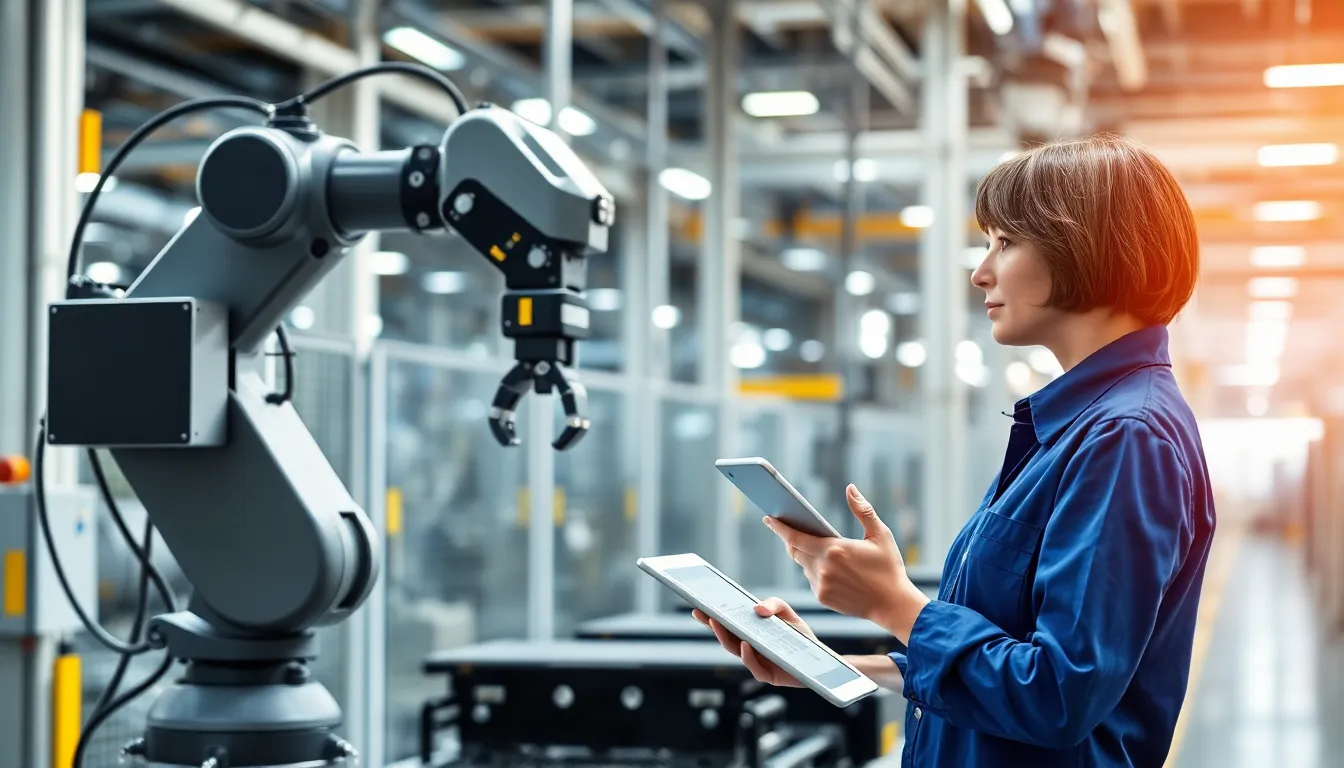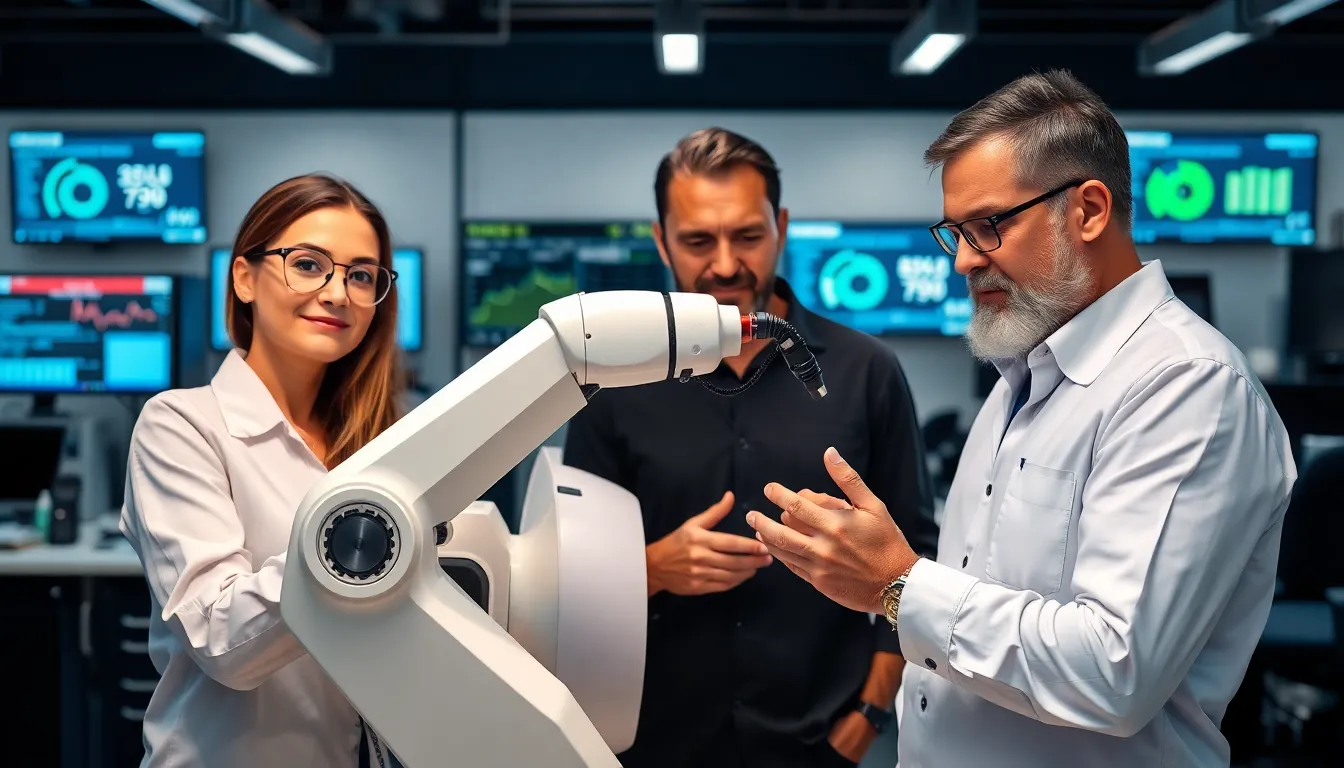In a world where coffee breaks are sacred and deadlines loom like storm clouds, enterprise robotics solutions are stepping in to save the day. Imagine a workforce that doesn’t need lunch breaks, can work 24/7, and never complains about the office temperature. Sounds like a dream, right? Well, it’s not just fantasy; it’s the future of business.
Table of Contents
ToggleOverview of Enterprise Robotics Solutions
Enterprise robotics solutions streamline processes in various industries. These solutions enhance productivity by automating tasks traditionally performed by humans. Businesses benefit from reduced operational costs and increased efficiency, leading to higher profit margins.
Robots in enterprise settings can handle diverse roles, from assembly line work to inventory management, providing flexibility and reliability. It’s noted that robotic systems operate continuously, without breaks, ensuring that operations run smoothly around the clock.
Integrating robotics can optimize workflows, allowing human workers to focus on more complex activities. Data shows that companies implementing these technologies experience improved accuracy and minimized errors, which directly impacts product quality.
Ongoing advancements in artificial intelligence drive the capabilities of enterprise robotics. Increased machine learning and data analytics enable robots to adapt quickly to changing environments and requirements. Such adaptability is crucial for staying competitive in rapidly evolving markets.
Investment in robotics presents significant long-term advantages, as these technologies continue to evolve. As a result, businesses that adopt these solutions often see accelerated growth and innovation. Adopting enterprise robotics is becoming a strategic priority for companies aiming to thrive in today’s demanding landscape.
Key Technologies in Enterprise Robotics

Enterprise robotics relies on several key technologies that enhance operational efficiency and capability. These innovations play a significant role in transforming industries and streamlining workflows.
Artificial Intelligence and Machine Learning
Artificial intelligence drives the decision-making process in robotics. Machine learning techniques help robots analyze data and improve performance over time. Robots equipped with AI can learn from previous tasks, enabling them to adapt to new challenges quickly. This adaptability enhances operational effectiveness, making robots valuable assets across various sectors. Employers see improved task execution due to AI-enhanced accuracy in decision-making and process adjustments.
Automation and Control Systems
Automation systems bring efficiency to repetitive tasks. Control systems coordinate robot actions, ensuring precise movements and functionality. These systems include advanced sensors that monitor the environment, providing real-time feedback and allowing immediate adjustments. Enhanced automation leads to significant time savings while minimizing human error, which is crucial in high-stakes situations. With effective control, robots can seamlessly interact with other machinery, resulting in smoother operations and streamlined production processes.
Applications of Enterprise Robotics in Various Industries
Enterprise robotics solutions find applications across diverse sectors, enhancing efficiency and productivity.
Manufacturing
In the manufacturing sector, robots play a vital role in automating assembly lines and precision tasks. Automated systems speed up production rates and minimize human error, improving overall quality. They can perform repetitive tasks consistently, ensuring high output levels. Robots also assist in quality control, inspecting products for defects and maintaining standards. Factories equipped with robotic systems often experience reduced labor costs, allowing companies to allocate resources strategically. This technology helps businesses adapt to market demands by scaling production seamlessly.
Logistics and Supply Chain
Robotics significantly transform logistics and supply chain management by streamlining processes. Automated guided vehicles (AGVs) and drones facilitate transportation of goods within warehouses. They navigate efficiently, reducing delivery times and operational costs. Sorting and packaging tasks become faster and more accurate with robotic assistance. Increased use of robotics enhances inventory management, reducing instances of overstocking or stockouts. Businesses that implement such technologies observe improved tracking and transparency throughout the supply chain, enabling better decision-making.
Healthcare
Healthcare organizations benefit greatly from enterprise robotics by improving patient care and operational efficiency. Surgical robots assist doctors by providing precision during operations, leading to better outcomes. Automation in pharmaceutical settings speeds up the production and distribution of medications, ensuring timely access for patients. Robots also support patient monitoring and assistance, enhancing the level of care in hospitals. The integration of robotics in healthcare helps reduce workload for staff, allowing personnel to focus on more critical tasks while ensuring high standards of treatment.
Benefits of Implementing Enterprise Robotics Solutions
Implementing enterprise robotics solutions offers numerous advantages for businesses in today’s competitive landscape.
Increased Efficiency and Productivity
Efficiency and productivity see substantial improvements through robotics integration. Robots operate continuously, performing tasks without breaks, thus maximizing output. They excel in repetitive tasks, allowing human workers to concentrate on complex projects requiring critical thinking. The combination of robotics and artificial intelligence enhances decision-making and process optimization. Industries leveraging robotics also report shorter production cycles and reduced lead times. This enhances overall workflow and supports businesses in meeting tight deadlines.
Cost Reduction
Cost reduction becomes evident when businesses adopt enterprise robotics solutions. Reduced labor costs often lead to improved profitability, as companies rely less on manual labor. Robots decrease the likelihood of human error, thus minimizing waste and rework costs. Automation in tasks such as inventory management lowers operational expenses and streamlines supply chain processes. Additionally, the longevity of robotic systems contributes to lower maintenance costs over time. These financial benefits position companies competitively while driving long-term sustainability.
Challenges and Considerations
Enterprise robotics solutions present various challenges and considerations that businesses must address for successful implementation.
Integration with Existing Systems
Integration with existing systems poses a significant challenge for companies. Many organizations rely on legacy systems that can complicate the introduction of new robotics technology. Teams must ensure compatibility between robotics and current software and hardware configurations. This consideration often requires system upgrades or modifications to facilitate seamless communication. Investing time and resources in proper integration mitigates disruption while maximizing efficiency. Companies need to evaluate their infrastructure requirements carefully and develop a strategic integration plan to optimize operations.
Workforce Impact and Skills Gap
The workforce impact demands attention as automation reshapes job roles. Many employees may experience shifts in responsibilities or job displacement as robotics take on repetitive tasks. Upskilling offers a solution, allowing workers to transition into roles that require enhanced skills. Companies benefit from investing in training programs that equip employees with the knowledge needed to work alongside robotics. Addressing the skills gap promotes workforce adaptability and fosters a culture of continuous learning. Organizations must communicate changes effectively, ensuring employees feel valued during the transition to a more automated environment.
Enterprise robotics solutions are reshaping the landscape of modern business. By automating repetitive tasks and enhancing operational efficiency, these technologies allow companies to focus on strategic initiatives that drive growth. The adaptability of robotics, powered by advancements in artificial intelligence and machine learning, ensures that businesses can stay competitive in fast-paced markets.
While the transition to a robotic workforce presents challenges, the long-term benefits far outweigh the initial hurdles. Companies that invest in training and integration will find themselves better positioned to thrive. As the demand for efficiency and productivity continues to rise, embracing enterprise robotics is not just an option; it’s a necessity for businesses aiming to succeed in today’s dynamic environment.



